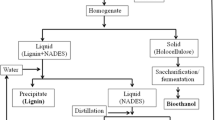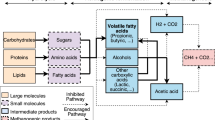Abstract
The aim of the present study was to examine ethanol production from concentrated food waste hydrolysates using whole cells of S. cerevisiae immobilized on corn stalks. In order to improve cell immobilization efficiency, biological modification of the carrier was carried out by cellulase hydrolysis. The results show that proper modification of the carrier with cellulase hydrolysis was suitable for cell immobilization. The mechanism proposed, cellulase hydrolysis, not only increased the immobilized cell concentration, but also disrupted the sleek surface to become rough and porous, which enhanced ethanol production. In batch fermentation with an initial reducing sugar concentration of 202.64 ± 1.86 g/l, an optimal ethanol concentration of 87.91 ± 1.98 g/l was obtained using a modified corn stalk-immobilized cell system. The ethanol concentration produced by the immobilized cells was 6.9% higher than that produced by the free cells. Ethanol production in the 14th cycle repeated batch fermentation demonstrated the enhanced stability of the immobilized yeast cells. Under continuous fermentation in an immobilized cell reactor, the maximum ethanol concentration of 84.85 g/l, and the highest ethanol yield of 0.43 g/g (of reducing sugar) were achieved at hydraulic retention time (HRT) of 3.10 h, whereas the maximum volumetric ethanol productivity of 43.54 g/l/h was observed at a HRT of 1.55 h.







Similar content being viewed by others
References
APHA (American Public Health Association), American Water Works Association, Water Environment Federation (1995) Standard methods for the examination of water and wastewater, 19th edn. APHA, Washington, DC
Baptista CMSG, Cóias JMA, Oliveira ACM, Oliveira NMC, Rocha JMS, Dempsey MJ, Lannigan KC, Benson PS (2006) Natural immobilization of microorganisms for continuous ethanol production. Enzyme Microb Tech 40:127–131
Behera S, Kar S, Mohanty RC, Ray RC (2010) Comparative study of bio-ethanol production from mahula (Madhuca latifolia L.) flowers by S. cerevisiae cells immobilized in agar agar and Ca-alginate matrices. Appl Energ 87:96–100
Bekers M, Laukevics J, Karsakevich A, Ventina E, Kaminska E, Upite D, Vina I, Linde R, Scherbaka R (2001) Levan-ethanol biosynthesis using Zymomonas mobilis cells immobilized by attachment and entrapment. Process Biochem 36:979–986
Chandel AK, Chan ES, Rudravaram R, Narasu ML, Rao LV, Pogaku R (2007) Economics and environmental impact of bio-ethanol production technologies: an appraisal. Biotechnol Mol Biol Rev 2:14–32
Chandel AK, Narasu ML, Chandrasekhar G, Manikyama A, Rao LV (2009) Use of Saccharum spontaneum (wild sugarcane) as biomaterial for cell immobilization and modulated ethanol production by thermotolerant S. cerevisiae VS3. Bioresource Technol 100:2404–2410
Chinese National Standard GB/T 22221 (2003) Determination of fructose, glucose, sucrose, maltose, lactose in foods—high performance liquid chromatography. Standards Press of China, Beijing
Chinese National Standard GB/T 5009.10 (2003) Determination of crude fiber in vegetable foods. Standards Press of China, Beijing
Diego TS, Boutros FS, Juan DR, Attilio C, Silvio SS (2008) Use of sugarcane bagasse as biomaterial for cell immobilization for xylitol production. J Food Eng 86:542–548
Gksungur Y, Gven U (1999) Production of lactic acid from beet molasses by calcium alginate immobilized Lactobacillus delbrueckii IFO 3202. J Chem Technol Bio 74:131–136
Göksungur Y, Zorlu N (2001) Production of ethanol from beet molasses by Ca-alginate immobilized yeast cells in a packed-bed bioreactor. Turk J Biol 25:265–275
Iqbal M, Saeed A (2005) Novel method for cell immobilization and its application for production of organic acid. Lett Appl Microbiol 40:178–182
Koike Y, An MZ, Tang YQ, Syo T, Osaka N, Morimura S, Kida K (2009) Production of fuel ethanol and methane from garbage by high-efficiency two-stage fermentation process. J Biosci Bioeng 108:508–512
Liu CZ, Wang F, Fan OY (2009) Ethanol fermentation in a magnetically fluidized bed reactor with immobilized S. cerevisiae in magnetic particles. Bioresource Technol 100:878–882
Marica R, Ljiljana M, Svetlana N, Maja V, Viktor N (2009) Bioethanol production by immobilized S. cerevisiae var. ellipsoideus cells. Afr J Biotechnol 8:464–471
Miller GL (1959) Use of dinitrosalicylic acid reagent for determination of reducing sugar. Anal Chem 31:426–428
Nikolic S, Mojovic L, Rakin M, Pejin D (2009) Bioethanol production from corn meal by simultaneous enzymatic saccharification and fermentation with immobilized cells of S. cerevisiae var. ellipsoideus. Fuel 88:1602–1607
Ogbonna JC, Tomiyama S, Liu YC, Tanka H (1997) Effcient production of ethanol by cells immobilized in loofa (Luffa cylindrica) sponge. J Ferment Bioeng 84:271–274
Phisalaphong M, Budiraharjo R, Bangrak P, Mongkolkajit J, Limtong S (2007) Alginate-loofa as carrier matrix for ethanol production. J Biosci Bioeng 104(3):214–217
Rezaee A, Godini H, Bakhtou H (2008) Microbial cellulose as support material for the immobilization of denitrifying bacteria. Environ Eng Manag J 7:589–594
Singh NL, Srivastava P, Mishra PK (2009) Studies on ethanol production using immobilized cells of Kluyveromyces thermotolerans in a packed bed reactor. J Sci Ind Res 68:617–623
Sun KH, Hang SS (2004) Biohydrogen production by anaerobic fermentation of food waste. Int J Hydrogen Energ 29:569–577
Vesna V, Radojka R, Mario R (2008) A corn stem as biomaterial for S. cerevisiae cells immobilization for the ethanol production. Chem Ind Chem Eng Q 14:235–238
Vogelsang C, Wijffels RH, Ostgaard K (2000) Rheological properties and mechanical stability of new gel-entrapment system applied in bioreactors. Biotechnol Bioeng 70:247–253
Wang Q, Yamabe K, Narita J, Morishita M, Ohsumi Y, Kusano K (2001) Suppression of growth of putrefactive and food poisoning bacteria by lactic acid fermentation of kitchen waste. Process Biochem 37:351–357
Wang XM, Wang QH, Ren NQ, Wang XQ (2005) Lactic acid production from kitchen waste with a newly characterized strain of Lactobacillus plantarum. Chem Biochem Eng Q 19(4):383–389
Wu GF, Li GQ, Ma YQ (1984) The analysis of industrial fermentation, 2nd edn. Chinese Light Industry Press, Beijing
Yan SB, Li J, Chen XS, Wu JY, Wang PC, Ye JF, Yao JM (2011a) Enzymatical hydrolysis of food waste and ethanol production from the hydrolysate. Renew Energ 36:1259–1265
Yan SB, Wang PC, Zhai ZJ, Yao JM (2011b) Fuel ethanol production from concentrated food waste hydrolysates in immobilized cell reactors by S. cerevisiae H058. J Chem Technol Biotechnol 26(5):731–738
Yu JL, Yue GJ, Zhong J, Zhang X, Tan TW (2005) Immobilization of S. cerevisiae to modified bagasse. Renew Energ 35:1130–1134
Yu JL, Zhang X, Tan TW (2007) An novel immobilization method of Saccharomyces cerevisiae to sorghum bagasse for ethanol production. J Biotechnol 129:415–420
Yu JL, Zhang X, Tan TW (2009) Optimization of media conditions for the production of ethanol from sweet sorghum juice by immobilized S. cerevisiae. Biomass Bioenerg 33:521–526
Zhang B, Zhang LL, Zhang SC, Shi HZ, Cai WM (2005) The influence of pH on hydrolysis and acidogenesis of kitchen wastes in two-phase anaerobic digestion. Environ Technol 26:329–339
Acknowledgments
The present research was financially supported by the Chinese National Science and Technology Pillar Program in the Eleventh Five-year Plan Period (Grant No. 2007BAD89B10-5(5)).
Author information
Authors and Affiliations
Corresponding author
Rights and permissions
About this article
Cite this article
Yan, S., Chen, X., Wu, J. et al. Ethanol production from concentrated food waste hydrolysates with yeast cells immobilized on corn stalk. Appl Microbiol Biotechnol 94, 829–838 (2012). https://doi.org/10.1007/s00253-012-3990-7
Received:
Revised:
Accepted:
Published:
Issue Date:
DOI: https://doi.org/10.1007/s00253-012-3990-7




